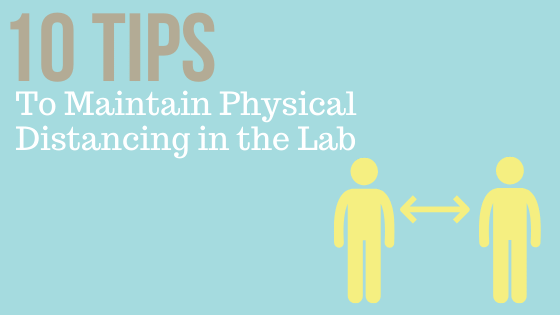Laboratories can be crowded places. We are used to working around other people, tossing ideas back and forth. Dark rooms, cold rooms and large equipment spaces are often shared by several labs. Some labs have shut down completely in response to the COVID-19 pandemic; others, especially those labs doing research around coronavirus biology, testing and detection and drug development are running continually. For those labs, maintaining the recommended 6-foot (2m) distance to help stem the coronavirus pandemic isn’t easy.
Written by: Michele Arduengo, Promega
Here are a few ways we have found to maintain critical distances in our laboratory that might help your lab group stay productive and safe too.
- Work in shifts. Have half of your staff working at any one time. Myra Schink, Manager of Bulk Production (Protein Purification) at Promega says that partners in a purification process for her group work every other day. Myra’s team also adds some fun to the shift work by giving the teams creative names. When the one team is on site, no person from the other team can come to the building and vice versa. This dramatically reduces the number of people on site, and facilitates physical distancing.
- Designate entrance and exit doors and break areas for each shift. Eliminating or minimizing the common space that different groups use can help prevent spread of virus from one group of workers to another. Have separate entrances and exits designated for teams, if possible. Assign parts of common areas like break rooms to different teams to minimize crossover.
- If you can work remotely, do so. Lab members can stay connected for group meetings and journal clubs using remote meeting software like Zoom or Skype. Often, office personnel are working from home, but lab members can do that too. At Promega Biosciences, chemists are asked to do analysis and writing work from home.
- If you must be in confined spaces, stagger the work. Ensure that dark rooms, negative-pressure labs and hot lab areas are used by one person at a time. This requires communication among all lab members, and may even require communication between labs in a department that share equipment like autoclaves, dishwashers and centrifuges.
- When two people must work in proximity, set up barriers. Barriers include things like lab coats, gloves, masks and safety glasses. They can also be closed doors and portable space dividers or even a bench-top incubator placed strategically between two individual work areas.
- Create a “mud room” for the lab. Find a place where you can remove your outside shoes and coats and change them for a lab coat, a different set of shoes or maybe put on lab booties.
- Make a place for that PPE to be discarded or hung up before you leave the lab. Lab coats, gloves, masks and other PPE should never leave a laboratory, in any circumstance, but in a pandemic this guideline takes on extra importance.
- Follow the CDC guidelines for disinfecting laboratory surfaces. Remember that surfaces are not just the lab bench but include things like doorknobs, light switches, common equipment, computer keyboards, shared pipettes, and microscope oculars. Have a routine set up and train your lab members to disinfect areas after finishing their work. Have a sign out procedure so that the next person in the lab space knows that it has been cleaned.
- Ask your Health and Safety experts at your institution to assess your laboratory and make recommendations.
- Our Chief Medical Officer at Promega reminds us that the number one method of infection is far and away “self-inoculation”…or touching your face…which means our number 1 method of prevention rests in our own CLEAN hands.”
These are a few suggestions for maintaining physical distancing and laboratory productivity during the current epidemic. How are your laboratories tackling this problem? Leave a comment on our social media channels to share your creative solutions.
WOULD YOU LIKE TO SEE MORE ARTICLES LIKE THIS? SUBSCRIBE TO THE ISHI BLOG BELOW!
SUBSCRIBE NOW!


